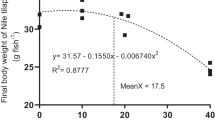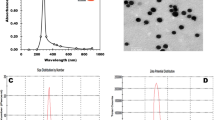Abstract
This experiment was to study the effects of zinc oxide nanoparticles (ZnO-NPs) on growth, intestinal barrier, oxidative status, and mineral deposition. In total, 256 one-day-old chicks were randomly allotted to 4 dietary groups and fed with basal diet plus 80 mg/kg ZnSO4 (ZnSO4 group) or plus 40, 80, and 160 mg/kg ZnO-NPs, respectively, for 21 days. Compared with the ZnSO4 group, dietary 40, 80, and 160 mg/kg ZnO-NPs did not alter growth (average daily gain, body weight, and gain to feed ratio), and serum activities of glutamic-pyruvic transaminase, alkaline phosphatase and glutamic oxalacetic transaminase (P > 0.05). However, dietary 80 and 160 mg/kg ZnO-NPs linearly decreased serum D-lactate content and diamine oxidase activity (P < 0.01). Moreover, 80 mg/kg ZnO-NPs enhanced zonula occludens-1 (ZO-1) mRNA expression in jejunal mucosa (P = 0.02). Dietary ZnO-NPs increased total antioxidant capacity activity (P = 0.01), and 80 mg/kg ZnO-NPs decreased malondialdehyde content in jejunal mucosa as compared to the ZnSO4 group (P = 0.02). In contrast, dietary ZnO-NPs did not alter mRNA expressions of superoxide dismutase, catalase, glutathione peroxidase, glutathione S-transferase, heme oxygennase-1 (HO-1) and NAD (P)H: quinone oxidoreductase 1 (NQO1) (P > 0.05). No significant difference was found in selected mineral concentrations (Mn, Cu, Fe and Zn) in the liver among ZnSO4 and 3 ZnO-NP groups (P > 0.05). However, 160 mg/kg ZnO-NPs increased fecal contents of Zn, Fe and Cu (P < 0.01), but did not affect fecal Mn level (P > 0.05). Therefore, results suggested that ZnO-NPs could be an additive to enhance the intestinal barrier and antioxidant capacity of broiler chicks, whereas the inclusion of 80 mg/kg would be more efficient.



Similar content being viewed by others
Data and materials availability
The data and materials of this study will be made available on reasonable request.
References
Oviedo-Rondón EO (2019) Holistic view of intestinal health in poultry. Anim Feed Sci Tech 250:1–8. https://doi.org/10.1016/j.anifeedsci.2019.01.009
Choct M (2009) Managing gut health through nutrition. Br Poult Sci 50:9–15. https://doi.org/10.1080/00071660802538632
Yegani M, Korver D (2008) Factors affecting intestinal health in poultry. Poult Sci 87:2052–2063. https://doi.org/10.3382/ps.2008-00091
Awad WA, Hess C, Hess M (2017) Enteric pathogens and their toxin-induced disruption of the intestinal barrier through alteration of tight junctions in chickens. Toxins 9:60. https://doi.org/10.3390/toxins9020060
Mishra B, Jha R (2019) Oxidative stress in the poultry gut: potential challenges and interventions. Front Vet Sci 6:60. https://doi.org/10.3389/fvets.2019.00060
Quinteiro-Filho WM, Ribeiro A, Ferraz-de-Paula V, Pinheiro ML, Sakai M, Sá LR, Ferreira AJ, Palermo-Neto J (2010) Heat stress impairs performance parameters, induces intestinal injury, and decreases macrophage activity in broiler chickens. Poult Sci 89:1905–1914. https://doi.org/10.3382/ps.2010-00812
Brewer M, Rojas M (2008) Consumer attitudes toward issues in food safety. J Food Saf 28:1–22. https://doi.org/10.1111/j.1745-4565.2007.00091.x
Morgan N (2017) Managing gut health without reliance on antimicrobials in poultry. Anim Prod Sci 57:2270–2279. https://doi.org/10.1071/AN17288
Choi S, Liu X, Pan Z (2018) Zinc deficiency and cellular oxidative stress: prognostic implications in cardiovascular diseases. Acta Pharmacol Sin 39:1120–1132. https://doi.org/10.1038/aps.2018.25
National Research Council (1994) Nutrient requirements of poultry. 9th rev. ed. National Academic Press, Washington, DC
De Grande A, Leleu S, Delezie E, Rapp C, De Smet S, Goossens E, Haesebrouck F, Van Immerseel F, Ducatelle R (2020) Dietary zinc source impacts intestinal morphology and oxidative stress in young broilers. Poult Sci 99:441–453. https://doi.org/10.3382/ps/pez525
Sunder GS, Panda AK, Gopinath N et al (2008) Effects of higher levels of Zinc supplementation on performance, mineral availability, and immune competence in broiler chickens. J Appl Poult Res 17:79–86
Zhu C, Lv H, Chen Z, Wang L, Wu XJ, Chen ZJ, Zhang WN, Liang R, Jiang ZY (2017) Dietary zinc oxide modulates antioxidant capacity, small intestine development, and jejunal gene expression in weaned piglets. Biol Trace Elem Res 175:331–338. https://doi.org/10.1007/s12011-016-0767-3
Sandoval M, Henry PR, Ammerman CB, Miles RD, Littell RC (1997) Relative bioavailability of supplemental inorganic zinc sources for chicks. J Anim Sci 75:3195–3205. https://doi.org/10.2527/1997.75123195x
Bauer LA, Birenbaum NS, Meyer GJ (2004) Biological applications of high aspect ratio nanoparticles. J Mater Chem 14:517–526. https://doi.org/10.1039/b312655b
Swain PS, Rao SBN, Rajendran D, Dominic G, Selvaraju S (2016) Nano zinc, an alternative to conventional zinc as animal feed supplement: a review. Anim Nutr 2:134–141. https://doi.org/10.1016/j.aninu.2016.06.003
Croteau MN, Dybowska AD, Luoma SN, Valsamijones E (2011) A novel approach reveals that zinc oxide nanoparticles are bioavailable and toxic after dietary exposures. Nanotoxicology 5:79–90. https://doi.org/10.3109/17435390.2010.501914
Zhao CY, Tan SX, Xiao XY, Qiu XS, Pan JQ, Tang ZX (2014) Effects of dietary zinc oxide nanoparticles on growth performance and antioxidative status in broilers. Biol Trace Elem Res 160:361–367. https://doi.org/10.1007/s12011-014-0052-2
Antoine TE, Hadigal SR, Yakoub AM, Mishra YK, Bhattacharya P, Haddad C, Valyi-Nagy T, Adelung R, Prabhakar BS, Shukla D (2016) Intravaginal zinc oxide tetrapod nanoparticles as novel immunoprotective agents against genital herpes. J Immunol 196:4566–4575. https://doi.org/10.4049/jimmunol.1502373
Wang C, Zhang L, Ying Z, He J, Zhou L, Zhang L, Zhong X, Wang T (2018) Effects of dietary zinc oxide nanoparticles on growth, diarrhea, mineral deposition, intestinal morphology, and barrier of weaned piglets. Biol Trace Elem Res 185:364–374. https://doi.org/10.1007/s12011-018-1266-5
Wang C, Lu J, Zhou L, Li J, Xu J, Li W, Zhang L, Zhong X, Wang T (2016) Effects of long-term exposure to zinc oxide nanoparticles on development, zinc metabolism and biodistribution of minerals (Zn, Fe, Cu, Mn) in mice. PLoS ONE 11. https://doi.org/10.1371/journal.pone.0164434
Sabir S, Arshad M, Chaudhari SK (2014) Zinc oxide nanoparticles for revolutionizing agriculture: synthesis and applications. Sci World J 2014:1–8. https://doi.org/10.1155/2014/925494
Shen MM, Zhang LL, Chen YN, Zhang YY, Han HL, Niu Y, He JT, Zhang YL, Cheng YF, Wang T (2019) Effects of bamboo leaf extract on growth performance, meat quality, and meat oxidative stability in broiler chickens. Poult Sci 98:6787–6796. https://doi.org/10.3382/ps/pez404
Chen Y, Cheng Y, Li X, Zhang H, Yang W, Wen C, Zhou Y (2016) Dietary palygorskite supplementation improves immunity, oxidative status, intestinal integrity, and barrier function of broilers at early age. Anim Feed Sci Technol 219:200–209. https://doi.org/10.1016/j.anifeedsci.2016.06.013
Livak KJ, Schmittgen TD (2001) Analysis of relative gene expression data using real-time quantitative PCR and the 2(-Delta Delta C(T)) Method. Methods 25:402–408. https://doi.org/10.1006/meth.2001.1262
Zhang B, Shao Y, Liu D, Yin P, Guo Y, Yuan J (2012) Zinc prevents Salmonella enterica serovar Typhimurium-induced loss of intestinal mucosal barrier function in broiler chickens. Avian Pathol 41:361–367. https://doi.org/10.1080/03079457.2012.692155
Sirelkhatim A, Mahmud S, Seeni A, Kaus NHM, Ann LC, Bakhori SKM, Hasan H, Mohamad D (2015) Review on zinc oxide nanoparticles: antibacterial activity and toxicity mechanism. Nanomicro Lett 7:219–242. https://doi.org/10.1007/s40820-015-0040-x
Talebian N, Amininezhad SM, Doudi M (2013) Controllable synthesis of ZnO nanoparticles and their morphology-dependent antibacterial and optical properties. J Photoch Photobio B 120:66–73. https://doi.org/10.1016/j.jphotobiol.2013.01.004
Ahmad M, Zhu J (2010) ZnO based advanced functional nanostructures: synthesis, properties and applications. J Mater Chem 21:599–614. https://doi.org/10.1039/c0jm01645d
Zhang L, Jiang Y, Ding Y, Povey M, York D (2007) Investigation into the antibacterial behaviour of suspensions of ZnO nanoparticles (ZnO nanofluids). J Nanopart Res 9:479–489. https://doi.org/10.1007/s11051-006-9150-1
Wang C, Cheng K, Zhou L, He J, Zheng X, Zhang L, Zhong X, Wang T (2017) Evaluation of long-term toxicity of oral zinc oxide nanoparticles and zinc sulfate in mice. Biol Trace Elem Res 178:276–282. https://doi.org/10.1007/s12011-017-0934-1
Wang MQ, Wang C, Li H, Du YJ, Tao WJ, Ye SS, He YD (2012) Effects of chromium-loaded chitosan nanoparticles on growth, blood metabolites, immune traits and tissue chromium in finishing pigs. Biol Trace Element Res 149:197–203. https://doi.org/10.1007/s12011-012-9428-3
Bai G, Li H, Ge Y, Zhang Q, Zhang J, Chen M, Liu T, Wang H (2018) Influence of hydrogen-rich saline on hepatocyte autophagy during laparoscopic liver ischaemia-reperfusion combined resection injury in miniature pigs. J Vet Res 62:395–403. https://doi.org/10.2478/jvetres-2018-0056
Zhou YP, Jiang ZM, Sun YH, He GZ, Shu H (2004) The effects of supplemental glutamine dipeptide on gut integrity and clinical outcome after major escharectomy in severe burns: a randomized, double-blind, controlled clinical trial. Clin Nutr 1:55–60. https://doi.org/10.1016/j.clnu.2004.07.012
Murray MJ, Barbose JJ, Cobb CF (1993) Serum D (-)-lactate levels as a predictor of acute intestinal ischemia in a rat model. J Surg Res 54:507–509. https://doi.org/10.1006/jsre.1993.1078
Tossou MC, Liu H, Bai M, Chen S, Cai Y, Duraipandiyan V, Liu H, Adebowale TO, Al-Dhabi NA, Long L, Tarique H, Oso AO, Liu G, Yin Y (2016) Effect of high dietary tryptophan on intestinal morphology and tight junction protein of weaned pig. Biomed Res Int 2016:1–6. https://doi.org/10.1155/2016/2912418
Suzuki T (2013) Regulation of intestinal epithelial permeability by tight junctions. Cell Mol Life Sci 70:631–659. https://doi.org/10.1007/s00018-012-1070-x
Wang C, Zhang L, Su W, Ying Z, He J, Zhang L, Zhong X, Wang T (2017) Zinc oxide nanoparticles as a substitute for zinc oxide or colistin sulfate: effects on growth, serum enzymes, zinc deposition, intestinal morphology and epithelial barrier in weaned piglets. PLoS ONE 12:e0181136. https://doi.org/10.1371/journal.pone.0181136
Kohen R, Nyska A (2002) Invited review: oxidation of biological systems: oxidative stress phenomena, antioxidants, redox reactions, and methods for their quantification. Toxicol Pathol 30:620–650. https://doi.org/10.1080/01926230290166724
Bai MM, Liu HN, Xu K, Wen CY, Yu R, Deng JP, Yin YL (2019) Use of coated nano zinc oxide as an additive to improve the zinc excretion and intestinal morphology of growing pigs. J Anim Sci 97:1772–1783. https://doi.org/10.1093/jas/skz065
Nguyen T, Nioi P, Pickett CB (2009) The Nrf2-antioxidant response element signaling pathway and its activation by oxidative stress. J Biol Chem 284:13291–13295. https://doi.org/10.1074/jbc.R900010200
Shin SM, Yang JH, Ki SH (2013) Role of the Nrf2-ARE pathway in liver diseases. Oxid Med Cell Longev 2013:1–9. https://doi.org/10.1155/2013/763257
Willis MS, Monaghan SA, Miller ML, McKenna RW, Perkins WD, Levinson BS, Bhushan V, Kroft SH (2005) Zinc-induced copper deficiency: a report of three cases initially recognized on bone marrow examination. Am J Clin Pathol 123:125–131. https://doi.org/10.1309/v6gvyw2qtyd5c5pj
Hamilton R, Fox M, Fry B, Jones A, Jacobs R (1979) Zinc interference with copper, iron and manganese in young Japanese quail. J Food Sci 44:738–741. https://doi.org/10.1111/j.1365-2621.1979.tb08488.x
Wang B, Feng W, Wang M, Wang T, Gu Y, Zhu M, Ouyang H, Shi J, Zhang F, Zhao Y (2008) Acute toxicological impact of nano-and submicro-scaled zinc oxide powder on healthy adult mice. J Nanopart Res 10:263–276. https://doi.org/10.1007/s11051-007-9245-3
Van Campen DR, Scaife PU (1967) Zinc interference with copper absorption in rats. J Nutr 91:473–476. https://doi.org/10.1093/jn/91.4.473
Jondreville C, Revy PS, Dourmad JY (2003) Dietary means to better control the environmental impact of copper and zinc by pigs from weaning to slaughter. Livest Prod Sci 84:147–156. https://doi.org/10.1016/j.livprodsci.2003.09.011
Acknowledgements
Thanks for the help of Liren Ding (College of Animal Science and Technology, Nanjing Agricultural University) in dealing with samples for the analysis of mineral concentrations.
Funding
This study was financially supported by the National Natural Science Foundation of China (No. 31972598).
Author information
Authors and Affiliations
Contributions
Conceived and designed the experiments: C.W. and T.W.; performed: J.Z. (Jiaqi Zhang), C.Y., C.W., Z.L. and J.L.; analyzed the data: J.Z. (Jiaqi Zhang) and C.W.; contributed reagents/materials/analysis tools: J.Z. (Jiaqi Zhang), C.W. and Y.C. and wrote the manuscript: J.Z. and C.W. All authors have read and agreed to the published version of the manuscript.
Corresponding author
Ethics declarations
Ethics approval and consent to participate
This experiment was approved and carried out under the Institutional Animal Care and Use Committee of Nanjing Agricultural University (Jiangsu, China). The number of the ethics committee-approved protocol for the animal study is SYXK-2019–00017.
Consent for publication
Not applicable.
Competing interests
The authors declare no competing interests.
Additional information
Publisher’s Note
Springer Nature remains neutral with regard to jurisdictional claims in published maps and institutional affiliations.
Supplementary Information
Below is the link to the electronic supplementary material.
Rights and permissions
About this article
Cite this article
Zhang, J., Yu, C., Li, Z. et al. Effects of Zinc Oxide Nanoparticles on Growth, Intestinal Barrier, Oxidative Status and Mineral Deposition in 21-Day-Old Broiler Chicks. Biol Trace Elem Res 200, 1826–1834 (2022). https://doi.org/10.1007/s12011-021-02771-6
Received:
Accepted:
Published:
Issue Date:
DOI: https://doi.org/10.1007/s12011-021-02771-6




